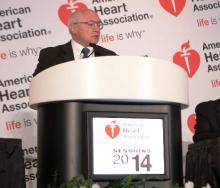CHICAGO – Optimal guideline-directed medical therapy appears more important than routine coronary CT screening in preventing death and cardiac events in patients with diabetes at high risk for asymptomatic coronary artery disease, the FACTOR-64 trial suggests.
At an average follow-up of 4 years, routine coronary computed tomography angiography (CCTA) failed to significantly reduce the primary composite endpoint of all-cause mortality, nonfatal myocardial infarction, or hospitalization for unstable angina, compared with medical management in the intent-to-treat analysis (6.2% vs. 7.6%, respectively; hazard ratio, 0.80; P = .38).
Event rates were also similar between groups in the as-treated analysis (5.6% vs. 7.9%; HR, 0.69; P = .16), study author Dr. Joseph Brent Muhlestein reported at the American Heart Association scientific sessions.
These findings do not support CCTA screening in this population,” he said.
CCTA screening, however, did reveal coronary artery disease in 70% of patients, prompting a recommendation for additional diagnostics and/or more aggressive management of risk factors. This resulted in modest but significant improvements in lipid subfractions and blood pressure levels in the CCTA group and coronary revascularization procedures in 5.8%, Dr. Muhlestein, with the Intermountain Heart Institute in Murray, Utah, said.
FACTOR-64 randomized 900 patients with type 1 or 2 diabetes for at least 3-5 years and without CAD symptoms to 64-slice CCTA screening or standard guideline-based optimal diabetes care including a target hemoglobin A1c level of less than 7.0%, LDL cholesterol level below 100 mg/dL, and systolic BP less than 130 mm Hg. Based on CCTA findings, recommendations were made for standard or aggressive therapy (HbA1c below 6.0%, LDL cholesterol under 70 mg/dL, HDL cholesterol greater than 50 mg/dL in women or above 40 mg/dL in men, triglycerides below 150 mg/dL, and systolic BP under 120 mm Hg) or aggressive therapy with invasive angiography. All patients were recruited from the Intermountain Healthcare system in Utah. Their mean age was 61 years.
The secondary composite endpoint of cardiovascular death, nonfatal myocardial infarction, or hospitalization for unstable angina was similar between the CCTA and control groups analyzed by intention to treat (4.6% vs. 5.1%, respectively; HR, 0.89; P = .70) and as-treated (4.1% vs. 5.6%; HR, 0.72; P = .30), according to the results, published online simultaneously (JAMA 2014 Nov. 17 [doi: 10.1001/jama.2014.15825]).
The overall annual event rates in both the control and intervention groups were low, at less than 2% per year. This may be attributed to the excellent medical management received by all patients, as evidenced by baseline levels near or exceeding system targets for HbA1c, LDL cholesterol, and systolic BP, Dr. Muhlestein said.
In an accompanying editorial (JAMA 2014 Nov. 17 [doi: 10.1001/jama.2014.15958]), Dr. Raymond Gibbons of the Mayo Clinic in Rochester, Minn., agreed that the findings are likely explained by the excellent baseline medical therapy.
“The data in this study suggest that Intermountain Healthcare has set a new published standard for what is achievable in patients with diabetes with respect to blood pressure control and lipid-lowering therapy and that, when therapy is applied this effectively, patients with diabetes are no longer at high risk for major cardiovascular events,” Dr. Gibbons wrote.
Invited discussant Dr. Pamela Douglas, professor of medicine at Duke University in Durham, N.C., said the key message is that the study was tested in a highly managed population, but that nationally less than 10% of diabetes patients are at goal for cardiovascular protection.
Dr. Douglas said CCTA screening may still have a limited role in asymptomatic patients if used to help patients adhere to treatment strategies that can improve outcomes. “This may be a bit roundabout, but that’s the one time,” she added.
Dr. Douglas also called for improved risk-prediction tools to identify even higher-risk individuals, observing that events were not confined to those with obstructive disease.
“We need to be looking for nonobstructive disease, which was in fact the hypothesis of this trial,” she said. “So perhaps we need to look beyond ischemia, beyond atherosclerosis to vulnerable plaque ... and cell targets.”
During the roundtable discussion of the study, panelists suggested that a coronary calcium score could play a role in identifying these higher-risk patients, and that telling a patient they have a calcium score of 800 may also get even the most stubborn diabetes patient to actually take their medications.
The study was supported by the Intermountain Research and Medical Foundation, Intermountain Heart Institute, and grants from Toshiba and Bracco. The study authors reported having no financial disclosures. Dr. Gibbons reported serving as a consultant for Lantheus Medical Imaging. Dr. Douglas reported no conflicts.



